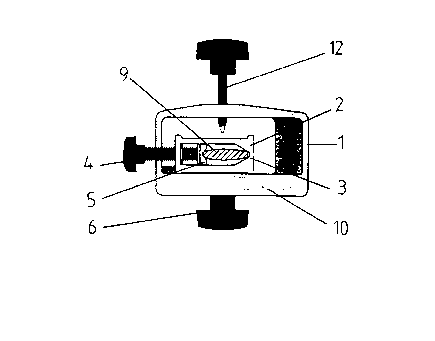Some of the information on this Web page has been provided by external sources. The Government of Canada is not responsible for the accuracy, reliability or currency of the information supplied by external sources. Users wishing to rely upon this information should consult directly with the source of the information. Content provided by external sources is not subject to official languages, privacy and accessibility requirements.
Any discrepancies in the text and image of the Claims and Abstract are due to differing posting times. Text of the Claims and Abstract are posted:
| (12) Patent Application: | (11) CA 2271171 |
|---|---|
| (54) English Title: | JIG FOR GRINDING SHARP-EDGED TOOLS |
| (54) French Title: | SUPPORT POUR AIGUISAGE D'OUTILS TRANCHANTS |
| Status: | Deemed Abandoned and Beyond the Period of Reinstatement - Pending Response to Notice of Disregarded Communication |
| (51) International Patent Classification (IPC): |
|
|---|---|
| (72) Inventors : |
|
| (73) Owners : |
|
| (71) Applicants : |
|
| (74) Agent: | NORTON ROSE FULBRIGHT CANADA LLP/S.E.N.C.R.L., S.R.L. |
| (74) Associate agent: | |
| (45) Issued: | |
| (22) Filed Date: | 1999-05-06 |
| (41) Open to Public Inspection: | 1999-11-13 |
| Availability of licence: | N/A |
| Dedicated to the Public: | N/A |
| (25) Language of filing: | English |
| Patent Cooperation Treaty (PCT): | No |
|---|
| (30) Application Priority Data: | ||||||
|---|---|---|---|---|---|---|
|
Jig for grinding sharp-edged tools. The jig consists of a housing (1) in the
form of a
casing designed with a passage running through it whose at least one end (10)
is flat, plus a seat
(2), also in the form of a casing designed with a passage running through it,
located in the
passage of the housing and lockable (6) in this housing in an inclined
position in relation to the
passage in the housing, whereby the seat (2) is provided with a clamping
device (4) for firmly
holding a tool that is to be ground so that it extends through the passage of
the seat, and that the
seat (2) has such a length that one end of it extends out beyond the housing
at the flat end (10) of
the housing.
Note: Claims are shown in the official language in which they were submitted.
Note: Descriptions are shown in the official language in which they were submitted.

2024-08-01:As part of the Next Generation Patents (NGP) transition, the Canadian Patents Database (CPD) now contains a more detailed Event History, which replicates the Event Log of our new back-office solution.
Please note that "Inactive:" events refers to events no longer in use in our new back-office solution.
For a clearer understanding of the status of the application/patent presented on this page, the site Disclaimer , as well as the definitions for Patent , Event History , Maintenance Fee and Payment History should be consulted.
| Description | Date |
|---|---|
| Inactive: IPC expired | 2012-01-01 |
| Inactive: IPC from MCD | 2006-03-12 |
| Inactive: IPC from MCD | 2006-03-12 |
| Time Limit for Reversal Expired | 2005-05-06 |
| Application Not Reinstated by Deadline | 2005-05-06 |
| Deemed Abandoned - Failure to Respond to Maintenance Fee Notice | 2004-05-06 |
| Inactive: Abandon-RFE+Late fee unpaid-Correspondence sent | 2004-05-06 |
| Inactive: Cover page published | 1999-11-19 |
| Application Published (Open to Public Inspection) | 1999-11-13 |
| Letter Sent | 1999-08-10 |
| Inactive: Single transfer | 1999-07-12 |
| Amendment Received - Voluntary Amendment | 1999-07-12 |
| Inactive: IPC assigned | 1999-06-25 |
| Inactive: First IPC assigned | 1999-06-25 |
| Inactive: Courtesy letter - Evidence | 1999-06-15 |
| Inactive: Filing certificate - No RFE (English) | 1999-06-10 |
| Filing Requirements Determined Compliant | 1999-06-10 |
| Application Received - Regular National | 1999-06-07 |
| Abandonment Date | Reason | Reinstatement Date |
|---|---|---|
| 2004-05-06 |
The last payment was received on 2003-04-14
Note : If the full payment has not been received on or before the date indicated, a further fee may be required which may be one of the following
Patent fees are adjusted on the 1st of January every year. The amounts above are the current amounts if received by December 31 of the current year.
Please refer to the CIPO
Patent Fees
web page to see all current fee amounts.
| Fee Type | Anniversary Year | Due Date | Paid Date |
|---|---|---|---|
| Application fee - standard | 1999-05-06 | ||
| Registration of a document | 1999-07-12 | ||
| MF (application, 2nd anniv.) - standard | 02 | 2001-05-07 | 2001-05-04 |
| MF (application, 3rd anniv.) - standard | 03 | 2002-05-06 | 2002-04-09 |
| MF (application, 4th anniv.) - standard | 04 | 2003-05-06 | 2003-04-14 |
Note: Records showing the ownership history in alphabetical order.
| Current Owners on Record |
|---|
| TORMEK AB |
| Past Owners on Record |
|---|
| TORGNY JANSSON |